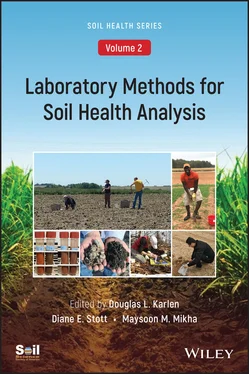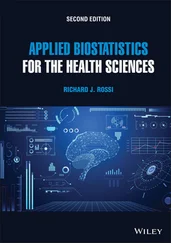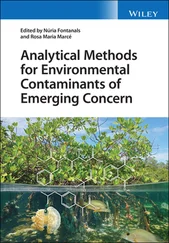Laboratory Methods for Soil Health Analysis, Volume 2
Здесь есть возможность читать онлайн «Laboratory Methods for Soil Health Analysis, Volume 2» — ознакомительный отрывок электронной книги совершенно бесплатно, а после прочтения отрывка купить полную версию. В некоторых случаях можно слушать аудио, скачать через торрент в формате fb2 и присутствует краткое содержание. Жанр: unrecognised, на английском языке. Описание произведения, (предисловие) а так же отзывы посетителей доступны на портале библиотеки ЛибКат.
- Название:Laboratory Methods for Soil Health Analysis, Volume 2
- Автор:
- Жанр:
- Год:неизвестен
- ISBN:нет данных
- Рейтинг книги:3 / 5. Голосов: 1
-
Избранное:Добавить в избранное
- Отзывы:
-
Ваша оценка:
- 60
- 1
- 2
- 3
- 4
- 5
Laboratory Methods for Soil Health Analysis, Volume 2: краткое содержание, описание и аннотация
Предлагаем к чтению аннотацию, описание, краткое содержание или предисловие (зависит от того, что написал сам автор книги «Laboratory Methods for Soil Health Analysis, Volume 2»). Если вы не нашли необходимую информацию о книге — напишите в комментариях, мы постараемся отыскать её.
Analyzing, comparing, and understanding soil health data Soil Health, Volume Two: Laboratory Methods for Soil Health Analysis
Laboratory Methods for Soil Health Analysis, Volume 2 — читать онлайн ознакомительный отрывок
Ниже представлен текст книги, разбитый по страницам. Система сохранения места последней прочитанной страницы, позволяет с удобством читать онлайн бесплатно книгу «Laboratory Methods for Soil Health Analysis, Volume 2», без необходимости каждый раз заново искать на чём Вы остановились. Поставьте закладку, и сможете в любой момент перейти на страницу, на которой закончили чтение.
Интервал:
Закладка:
Beta‐glucosidase activity (organic matter decomposition)
Macro‐aggregate stability (water partitioning)
Permanganate oxidizable carbon (carbon food source for microbes)
Soil protein (bioavailable nitrogen)
Ester‐linked fatty acid methyl ester; phospholipid fatty acid (microbial community structure, diversity)
Nematode population densities (trophic levels)
Pathogenic fungi populations or bioassays (pathogen activities and host ranges)
The SHI, SHD and Soil Renaissance communities also identified a category of measurements designated “Tier 3”, which are primarily measurements of soil biological properties or processes for which, again, there is scientific consensus that they are quite likely related to soil health, but they still require major research and development investments to determine whether they reveal information that can be used to improve soil and crop management decisions. Fundamental biological and agricultural principles suggest Tier 3 indicators may be very useful eventually for assessing soil health and making management decisions, provided significant research investments in their development are aggressively pursued. Therefore, Tier 3 measurements are worthy subjects of further research on long‐term research sites and on‐farm evaluations where there are detailed records of environmental conditions and management practices over enough years that Tier 3 measurements can be interpreted reliably. Prominent among such measurements are metagenomic analyses to reveal information about soil microbial populations, community structure, and diversity, as influenced by the status and trends of soil health and in relation to the history of environmental conditions and management practices on exceptionally well‐characterized sites.
Consensus on what to measure is just part of the research associated with soil health measurements. There is also a need to reach consensus on how to measure each indicator, which can be very challenging and even contentious within the soil science and agronomic research communities. In the case of Tier 1 indicators, many analytical methods for measurements are widely accepted, for example, Soil Science Society of America Book Series 5, Methods of Soil Analysis, second edition– Part 1 , Physical and Mineralogical Methods (1986); Part 2, Chemical and Microbiological Properties (1982); Part 3, Chemical Methods (1996). Variations in specific methods have been adapted in response to recommendations from research conducted in university, government, and private laboratories to obtain optimal, meaningful results for different soils collected from widely different locations and environments. These methods are in use for several different frameworks for soil health assessment (e.g., Karlen et al., 2014; Moebius‐Clune et al., 2016).
Methods for Tier 2 indicators are under active development and evaluation, and the research community is not in full agreement on methods and interpretation. Tier 3 indicators, however, as might be expected, are still very much in development, and their interpretation and value as soil health indicators that can be used to guide soil and crop management practice decisions remain uncertain.
To develop consensus that would support research on Tier 1 and Tier 2 indicator evaluation, in early 2018, the SHI assembled a panel of experts in soil health measurement from USDA agencies (Agricultural Research Service, Natural Resources Conservation Service), universities, and a private laboratory to meet and recommend a specific protocol for each indicator listed below. The goal for this gathering was to assemble a definitive list of widely‐applicable, effective indicators for evaluating soil health and the specific methods to use for each indicator in many production environments across a wide geographical scale. To accomplish this, SHI is partnering with numerous investigators at long‐term agricultural research sites (with appropriate experimental designs, controls, documented management histories, production records, etc.) that are being sampled and analyzed for over 30 soil health indicators ( www.soilhealthinstitute.org/north‐american‐project‐to‐evaluate‐soil‐health‐measurements/) (accessed February 20, 2020). Together, the indicator methods described in USDA‐SHD Technical Note 450–03 (Stott, 2019), information provided in this volume, and methods under evaluation in the wide‐scale SHI project ( Tables 1.1and 1.2) offer researchers and others who need scientifically justifiable procedures a good selection for current use, comparison, testing in different locations and agricultural production conditions, and further refinement.
Measurements and methods in Tables 1.1and 1.2are the subjects of ongoing research being conducted by the SHI with university, government, and private‐sector partners with funding (2017–2020) from the Foundation for Food and Agriculture Research, General Mills, The Samuel Roberts Noble Foundation, and matching‐fund sources. The indicators under investigation by NRCS are a subset of those being evaluated by SHI, and both organizations coordinated to use the same methods for those specific indicators.
What Do Commercial Analytical Laboratories Need?
The primary interest of researchers usually is a level of accuracy, precision, and explanatory linkage to processes occurring in soil, so that results can be used to explain and predict soil health in a way that leads to new ways of managing the soil resource. In most cases, the limits on accuracy and precision, and the QA/QC procedures to ensure desired data quality and curation, are specified by the individual researcher as needed for the goals of the research and as constrained by the research budget.
Analytical laboratories that measure soil properties for a fee are also concerned with accuracy and precision that reflect the reliability and reputation of their service. Relationships between measurements and soil processes elucidated in research laboratories underlie a service lab’s analytical offerings, but in most cases, such relationships have been worked out by the research community. Although cost is certainly a consideration in a research budget, a service lab must offer analyses in a consistent, cost‐effective, and competitive way to remain in business. Selection of specific methods often relies on recommendations from researchers at universities located within the general region from which a service lab draws customers; such methods are most likely to yield reliable results for the region in which they were developed.
Table 1.1 Tier 1 Soil Health Indicators and Methods to be Assessed.
| Indicator | Method | Reference |
|---|---|---|
| Soil pH | 1:2 soil:water, standard pH electrode system | Thomas, 1996 |
| Soil Electrical Conductivity (EC) | 1:2 soil:water, standard electrical conductivity meter system | Rhoades, 1996 |
| Cation Exchange Capacity (CEC) | Sum of cations: Soil pH ≥ 7.2: use ammonium acetate extractant; Soil pH < 7.2: use Mehlich 3 extractant | Knudsen et al., 1982 Sikora and Moore, 2014 |
| % Base Saturation (BS) | Calculation: For soil pH ≥ 7.2: use ammonium acetate extractant; for soil pH < 7.2: use Mehlich 3 extractant | Knudsen et al., 1982 Sikora and Moore, 2014 |
| Extractable Phosphorus | Soil pH ≥ 7.2: use sodium bicarbonate extractant; Soil pH < 7.2: use Mehlich 3 extractant | Olsen and Sommers, 1982 Sikora and Moore, 2014 |
| Extractable Potassium, Calcium, Magnesium, Sodium | pH ≥ 7.2: use ammonium acetate extractant; Soil pH < 7.2: use Mehlich 3 extractant | Knudsen et al., 1982 Sikora and Moore, 2014 |
| Extractable Iron, Zinc, Manganese, Copper | DTPA extractant derivatives | Lindsay and Norvell, 1978 |
| Total Nitrogen | Dry combustion | Nelson and Sommers, 1996 |
| Soil Organic Carbon (SOC) | Dry combustion; corrected for inorganic C, if present, using pressure calcimeter | Nelson and Sommers, 1996 Sherrod et al., 2002 |
| Soil Texture | Pipette method with a minimum of 3 size classes. Weight/volume measurements | Gee and Bauder, 1986 |
| Aggregate Stability | Wet sieve procedure. Weight measurement Water slaking image recognition | Kemper and Roseneau, 1986 Mikha and Rice, 2004 Fajardo et al., 2016 |
| Available Water Holding Capacity | Ceramic plate method measured at –33 kPa (–10 kPa for sandy soils) and –1500 kPa | Klute, 1986 |
| Bulk Density (BD) | Core method: diameter to be determined, (most likely 2‐inch or 5.08 cm) | Blake and Hartge, 1986 |
| Saturated Hydraulic Conductivity | Two‐ponding head method in field with Saturo | Reynolds and Elrick, 1990 |
| Crop Yield | Obtained from historical and current plot yield data provided by site manager | |
| Short‐Term Carbon Mineralization | 4‐d incubation followed by CO 2–C evolution and capture at 50% water‐filled pore space. | Zibilske, 1994 |
| Potentially Mineralizable Nitrogen | Short‐term anaerobic incubation with ammonium and nitrate measured colorimetrically pre‐ and post‐incubation | Bundy and Meisinger, 1994 |
Service labs must maintain consistent quality of data if they are to remain in business. A farmer must have confidence that analyses conducted in different years or on different parts of the farm reflect real properties of the soil, and if changes in a measurement are occurring, that these really do reflect changes in soil on the farm. Service labs may strive to achieve this reliability through associations with organizations that provide independent testing and verification of laboratory results.
Читать дальшеИнтервал:
Закладка:
Похожие книги на «Laboratory Methods for Soil Health Analysis, Volume 2»
Представляем Вашему вниманию похожие книги на «Laboratory Methods for Soil Health Analysis, Volume 2» списком для выбора. Мы отобрали схожую по названию и смыслу литературу в надежде предоставить читателям больше вариантов отыскать новые, интересные, ещё непрочитанные произведения.
Обсуждение, отзывы о книге «Laboratory Methods for Soil Health Analysis, Volume 2» и просто собственные мнения читателей. Оставьте ваши комментарии, напишите, что Вы думаете о произведении, его смысле или главных героях. Укажите что конкретно понравилось, а что нет, и почему Вы так считаете.












